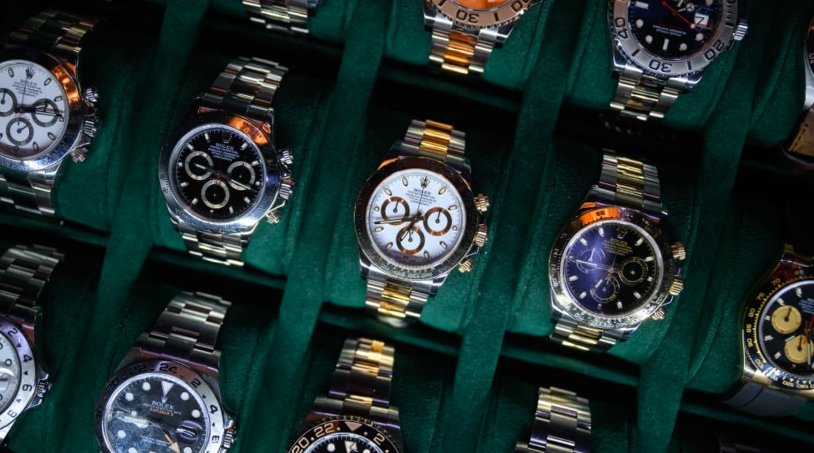The luxury watch market is facing a significant downturn as “crypto bros”—investors who once heavily traded in high-end timepieces—are pulling out. This shift has left a noticeable impact on the industry, with sales plummeting and the resale market struggling. The trend, which saw luxury watches being used as alternative investments, is now reversing, causing concern among luxury watch brands.
The Rise and Decline of Watch Flipping
During the cryptocurrency boom, many investors turned to luxury watches as a stable investment. High-end timepieces like Rolex and Patek Philippe became hot commodities, often reselling for much higher prices than their retail value. This trend was driven by the allure of quick profits and the perceived stability of luxury watches as assets.
However, as the cryptocurrency market has cooled, so has the enthusiasm for flipping watches. Investors who once saw these timepieces as a safe bet are now wary. The resale value of many popular models has dropped significantly, making it less attractive for speculators. This decline is partly due to a shift in investment strategies, with many opting for more liquid assets.

The impact on the luxury watch market has been profound. Brands that once enjoyed soaring sales are now facing a slump. The secondary market, which thrived on the back of crypto investments, is also feeling the pinch. Watches that once sold within weeks are now languishing for months, reflecting a broader market correction.
The Impact on Luxury Brands
Luxury watch brands are grappling with the fallout from this shift. Companies like Rolex and Patek Philippe, which kept supply low to drive demand, are now seeing their strategies backfire. The reduced interest from crypto investors has led to an oversupply in the market, further driving down prices.
This situation presents a unique challenge for luxury brands. They must navigate the delicate balance between maintaining exclusivity and adapting to changing market dynamics. Some brands are exploring new strategies, such as increasing direct-to-consumer sales and enhancing their digital presence. These efforts aim to attract a broader audience and mitigate the impact of declining resale values.
The shift also highlights the need for brands to diversify their customer base. Relying heavily on a single group of investors has proven risky. By broadening their appeal and targeting different demographics, luxury watch brands can build a more resilient market presence. This approach may involve creating more accessible product lines or emphasizing the craftsmanship and heritage of their timepieces.
Future Prospects for the Watch Market
Despite the current challenges, there are opportunities for the luxury watch market to rebound. The decline in speculative buying could lead to a more stable and sustainable market. Enthusiasts and collectors who value the artistry and history of luxury watches may find it easier to acquire coveted models without the inflated prices driven by speculators.
Brands are also likely to innovate in response to these market changes. We may see new designs, limited editions, and collaborations aimed at reigniting interest among traditional watch lovers. Additionally, the focus on sustainability and ethical production could attract a new generation of consumers who prioritize these values.
The luxury watch market’s future will depend on its ability to adapt and evolve. By learning from the current downturn and implementing strategic changes, brands can position themselves for long-term success. The lessons from the crypto boom and bust will undoubtedly shape the industry’s approach to marketing, production, and customer engagement in the years to come.
Finn Wells is a proficient news writer at Crypto Quill, specializing in delivering the latest updates on Bitcoin and altcoins to readers worldwide. With a keen interest in the ever-changing landscape of digital currencies, Finn’s articles provide insightful analysis and up-to-the-minute news on the cryptocurrency market. Known for his meticulous research and commitment to accuracy, Finn brings a fresh perspective to the world of blockchain technology. Stay informed with Finn’s comprehensive coverage of Bitcoin and altcoins, as he continues to illuminate the crypto space with his expertise and dedication at Crypto Quill.

 Bitcoin
Bitcoin  Ethereum
Ethereum  Tether
Tether  XRP
XRP  Solana
Solana  USDC
USDC  Dogecoin
Dogecoin  Cardano
Cardano  TRON
TRON  Lido Staked Ether
Lido Staked Ether  Wrapped Bitcoin
Wrapped Bitcoin  Chainlink
Chainlink  LEO Token
LEO Token  Toncoin
Toncoin  USDS
USDS  Stellar
Stellar  Wrapped stETH
Wrapped stETH  Avalanche
Avalanche  Sui
Sui  Shiba Inu
Shiba Inu  Hedera
Hedera  Litecoin
Litecoin  Polkadot
Polkadot  MANTRA
MANTRA  Bitcoin Cash
Bitcoin Cash  Bitget Token
Bitget Token  Ethena USDe
Ethena USDe  WETH
WETH  Binance Bridged USDT (BNB Smart Chain)
Binance Bridged USDT (BNB Smart Chain)  Pi Network
Pi Network  Wrapped eETH
Wrapped eETH  Hyperliquid
Hyperliquid  Monero
Monero  WhiteBIT Coin
WhiteBIT Coin  Uniswap
Uniswap  Dai
Dai  OKB
OKB  sUSDS
sUSDS  Pepe
Pepe  NEAR Protocol
NEAR Protocol  Aptos
Aptos  Gate
Gate  Coinbase Wrapped BTC
Coinbase Wrapped BTC  Tokenize Xchange
Tokenize Xchange  Cronos
Cronos  Ondo
Ondo  Mantle
Mantle  Ethereum Classic
Ethereum Classic  Internet Computer
Internet Computer  Aave
Aave  Ethena Staked USDe
Ethena Staked USDe  Cosmos Hub
Cosmos Hub  BlackRock USD Institutional Digital Liquidity Fund
BlackRock USD Institutional Digital Liquidity Fund  VeChain
VeChain  Official Trump
Official Trump  Bittensor
Bittensor  Ethena
Ethena  Filecoin
Filecoin  Lombard Staked BTC
Lombard Staked BTC  Render
Render  POL (ex-MATIC)
POL (ex-MATIC)  Celestia
Celestia  Algorand
Algorand  Sonic (prev. FTM)
Sonic (prev. FTM)  Arbitrum
Arbitrum  Solv Protocol SolvBTC
Solv Protocol SolvBTC  KuCoin
KuCoin  Optimism
Optimism  Artificial Superintelligence Alliance
Artificial Superintelligence Alliance  Jupiter
Jupiter  Maker
Maker  Story
Story  Binance-Peg WETH
Binance-Peg WETH  NEXO
NEXO  Binance Staked SOL
Binance Staked SOL  USDT0
USDT0  Movement
Movement  Stacks
Stacks  Worldcoin
Worldcoin  Rocket Pool ETH
Rocket Pool ETH  Bonk
Bonk  Binance Bridged USDC (BNB Smart Chain)
Binance Bridged USDC (BNB Smart Chain)  DeXe
DeXe  Usual USD
Usual USD  Injective
Injective  Polygon Bridged USDT (Polygon)
Polygon Bridged USDT (Polygon)  Sei
Sei  Theta Network
Theta Network  Immutable
Immutable  The Graph
The Graph  Lido DAO
Lido DAO  Tether Gold
Tether Gold